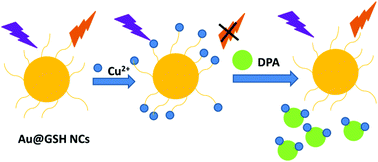Gold nanocluster-based fluorescence sensing probes for detection of dipicolinic acid†
Abstract
Bacillus spp. are spore-forming bacteria, and some of them, including Bacillus cereus and Bacillus anthracis, are pathogens. Dipicolinic acid (DPA) has been recognized as a biomarker for spore-forming bacteria. Thus, developing rapid sensing methods to spot the presence of DPA in suspicious samples is significant. In this study, we employ complexes of glutathione-capped gold nanoclusters (Au@GSH NCs) with Cu2+ as sensing probes against DPA. Au@GSH NCs possess orange-reddish fluorescence. However, their fluorescence is significantly quenched in the presence of Cu2+. In the presence of DPA, the fluorescence of Au@GSH NCs can be restored because DPA can easily remove Cu2+ on the NCs through chelation based on the high formation constant (log K = 7.97) between Cu2+ and DPA. Therefore, on the basis of this fact, Au@GSH NC–Cu2+ complexes are used as turn-on fluorescence probes against DPA. Unlike most of the existing sensing methods, the developed Au@GSH–Cu2+-based sensing method is not affected by the presence of phosphates, which can be commonly found in real samples. The limit of detection of using the developed sensing method toward DPA can reach as low as ∼19 nM. In addition, we also demonstrate the feasibility of using the developed sensing method for detection and quantification of DPA in soil samples and B. cereus spore lysates.



 Please wait while we load your content...
Please wait while we load your content...